D-LINK DP-301U User Manual

D-Link DP-301U
Fast Ethernet Print Server
Manual
Building Networks for People
Contents
Package Contents ................................................................................ |
3 |
Introduction............................................................................................ |
4 |
Setting up the DP-301U ........................................................................ |
7 |
Getting Started ...................................................................................... |
9 |
Using the Web Configuration ............................................................... |
10 |
TCP/IP Printing for Windows XP ........................................................ |
17 |
TCP/IP Printing for Windows 2000..................................................... |
25 |
TCP/IP Printing for Windows 98SE/Me .............................................. |
34 |
Unix/Linux Printing (See PS Admin Manual on CD-ROM) .................. |
45 |
Setting up AppleTalk or LPR Printing in MAC OSX .............................. |
46 |
Setting up AppleTalk Printing in MAC OS9 .......................................... |
51 |
Networking Basics .............................................................................. |
54 |
Technical Specifications ...................................................................... |
66 |
Contacting Technical Support .............................................................. |
67 |
Warranty and Registration ................................................................... |
68 |
Appendix: DP-301U Printer Compatibility List .................................... |
71 |
2

Package Contents
Contents of Package:
D-Link DP-301U
Fast Ethernet Print Server
Manual and Warranty on CD
Printed Quick Installation Guide
If any of the above items are missing, please contact your reseller.
System Requirements:
A computer with an installed Ethernet adapter
Windows XP/2000/ME/98SE
Apple Mac OS withAppleTalk
Linux
Internet Explorer 6.0, or Netscape Navigator version 6.0 or above, with JavaScript enabled
Printer must support required Operating System
3
Introduction
The D-Link DP-301U Print Server is an Ethernet print server that connects to your Ethernet/Fast Ethernet network anywhere you wish to locate USB printer services. The DP-301U manages the flow of print files from workstations or file servers to connected printers, delivering print jobs to printers much faster than a file server on a PC acting as a print server can. With one USB (v1.1) port, the DP-301U can connect to almost any printer with a USB port.
The DP-301U includes easy-to-use software to install on most Windows-based networks. Protocol support for TCP/IP, NetBEUI, and AppleTalk are provided to ensure seamless connection to major networking Operating Systems.
The DP-301U has a built in Web-Based management feature that allows users to easily configure and manage print queues through TCP/IP. The DP-301U also supports Telnet as an alternative method to configure the unit.
The DP-301U improves network printing services in the following ways:
The DP-301U delegates print jobs to the connect USB printer. This provides workload relief to your file servers and allows the file servers’ full capacity to be used for file access or other direct services to network users. On peer-to-peer networks, workstations can print directly to the Print Server without increasing the load of another workstation or server.
The DP-301U’s USB port, version 1.1, can transmit to high-speed laser printers much faster than a PC’s parallel printer port.
Because the DP-301U is very portable and inexpensive compared to a PC-based print server, and the Print Server connects to your file servers through the network, printers can be deployed to locations of maximum convenience to users.
4

The DP-301U offers extraordinary flexibility, operating with all major network operating systems and protocols:
TCP/IP
UNIX lpr/lpd
Windows NT/2000, Windows 95/98SE/ME, Windows XP NetWare 5.x NDPS LPR Remote Printing
NetBEUI
Windows 2000/XP, Windows 95/98SE/ME, Microsoft LAN Manager, IBM LAN Server
AppleTalk
MacOS EtherTalk
Windows-based setup and administration software, PS Admin, is supplied with the Print Server, making configuration and management quick and easy. The Print Server also supports configuration and management via the Telnet protocol for networks without Windows-compatible systems.
External Features
Port Connectors
The DP-301U’s USB port is located on its rear panel. The USB can be configured using the PS Admin program or the print server’s Telnet interface. (See the PS Admin User’s Guide, available on the CD that came with the DP-301U, for information about configuring the print server’s ports.) The Print Server also supports web configuration permitting users to configure settings through the web browser. The default IP Address is as follows:
Default IP Address – 192.168.0.10
Subnet Mask – 255.255.255.0
Note:
The PC’s IPAddress must be in the same subnet as the Print Server’s IPAddress for the two devices to communicate. (For example, if your Print Server’s IP Address is 192.168.0.10, with a subnet mask of 255.255.255.0, then your computer’s IP Address should be 192.168.0.x, where x is a value between 1-254, excluding 10.)
5
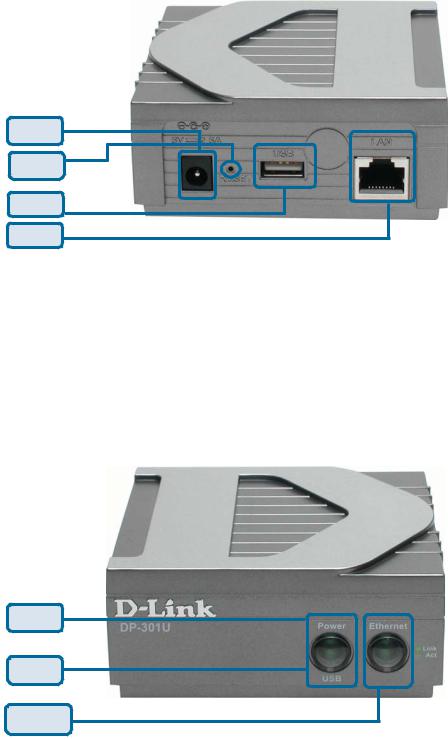
Rear Panel Connectors
Power
Reset
USB
RJ-45
Network Cable Connector
The Print Server’s rear panel features an RJ-45 connector for connection to 10Base-T Ethernet cabling or 100Base-TX Fast Ethernet cabling (which should be Category 5 twisted-pair cable). The port supports the NWay protocol, allowing the Print Server to automatically detect or negotiate the transmission speed of the network.
DC Power Connector
The DC power input connector is located on the Print Server’s rear panel and is labeled DC 5V.
LED Indicators
The front panel of the Print Server features five LED indicators:
Power
USB
Ethernet |
6 |

Front Panel LED Indicators
Power
Steady or flashing green light confirms that the Print Server is
powered ON.
Link/Act
Steady or flashing green light confirms that the Print Server has a good connection to the Ethernet or Fast Ethernet network.
The indicator blinks off briefly to indicate that the Print Server is receiving or transmitting from the network.
USB
The LED indicator lights up to show that the Print Server is transferring print data through the USB port.
These three indicators are also used by the Print Server’s Power-ON Self Test (POST) to indicate any hardware failures.
Setting up the DP-301U
Installing the Print Server
WARNING: Configuration problems may result if the Print Server is powered up without first establishing its network connection. Follow this procedure to avoid complications at the configuration stage.
1.Confirm proper operation of the printer to be connected to the DP-301U,
2.When you have confirmed proper operation of the USB printer, switch it the power OFF.
3.Confirm that your network is operating normally.
4.Connect the DP-301U RJ-45 Connector to the network, using a straight through CAT5 cable..
5.While the printer is powered OFF, install the USB printer cable to connect the printer’s USB port to the USB port of the Print Server.
6.Switch on the connected printer.
7.Plug the AC power adapter’s DC output plug into the DC 5V power socket on the rear panel of the Print Server.
8.Plug the power adapter into a power outlet. This will supply power to the Print Server, as it has no external power switch. The green Power LED on the Print Server’s front panel should illuminate steadily, and the Print Server’s
Self-Test will proceed. |
7 |
|

Power ON Self-Test
Every DP-301U has been factory-tested to operate properly.
When the DP-301U is powered ON, it also automatically performs a Self-Test on each of its major components. The final result of the Self-Test is signaled by the state of the USB LED indicator following the Self-Test. Preliminary to the actual component tests, the LED indicators are tested to confirm their steady and flashing operation.
Immediately after power-up, all three of the green LEDs should illuminate steadily for several seconds. Then the USB LED should flash ON three times. Irregularity of the LED during this LED test may mean there is a problem with the LED itself.
The actual component tests immediately follow the LED tests. A normal (no fault) result is signaled by a flashing of the USB LED, followed by a darkened LED.
If the Self-Test routine detects any component error, then following the LED tests the Self-Test will halt and the LEDs will continuously signal the error according to the following table. In the event of any such error signal, contact your dealer for correction of the faulty unit.
USB LED |
Faulty Component |
||
|
|
|
|
low speed flashing |
Need to reload firmware |
||
|
|
||
steady ON |
DRAM error |
||
1 long |
2 short |
TimerINTerror |
|
|
|
|
|
1 long |
3 short |
Flash Protected |
|
|
|
|
|
1 long |
5 short |
Flash Erase/Program error |
|
|
|
|
|
1 long |
6 short |
LAN Controller error |
|
|
|
|
|
1 long |
7 short |
LAN memory error |
|
|
|
||
1 long 11short |
LAN I/O base error |
||
1 long 18 short |
USB error |
||
|
|
|
|
8
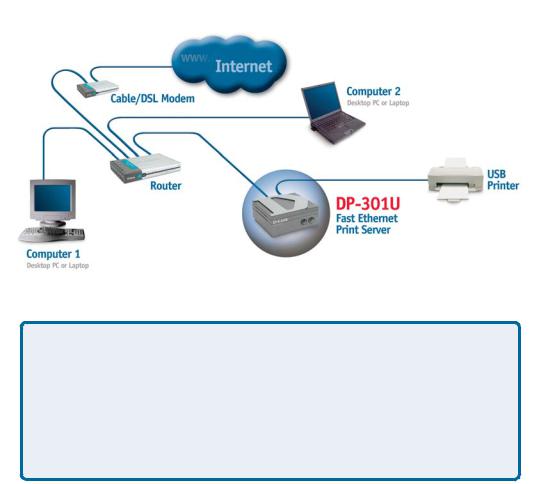
Getting Started
Below is a sample network using the DP-301U. The DP-301U has a builtin Web-based management feature that allows users to easily configure and manage their print queue through TCP/IP.
Warning!
Only a USB printer may be connected to the USB port of the DP-301U. Do not connect any other USB devices to the USB port of the DP-301U; to do so, may damage the unit and will void the warranty for this product.
For a list of printers that are compatible with the DP-301U, please see the Appendix in this manual. The compatibility list is not comprehensive. Even if it is not included in the list, your printer may be compatible with the DP-301U.
9
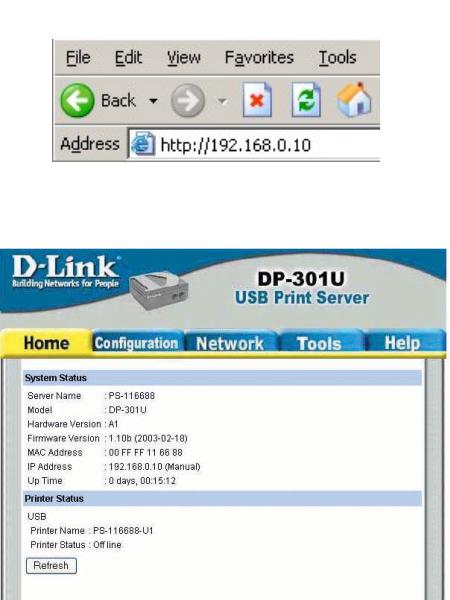
Using the Web Configuration
Open your web browser and type http://192.168.0.10 in the address box, and press <Enter>. This set of numbers is the default IP Address of your Print Server.
Please note that the PC’s IP Address must correspond with the Print Server’s IP Address in the same segment for the two devices to communicate.
When you entered the default IP address, the main screen of the Print Server’s configuration will appear (see below). In addition to the product information, you can access and control the Print Server’s configuration through four links on the top of this main screen: Home, Configuration, Network, Tools, and Help.
10
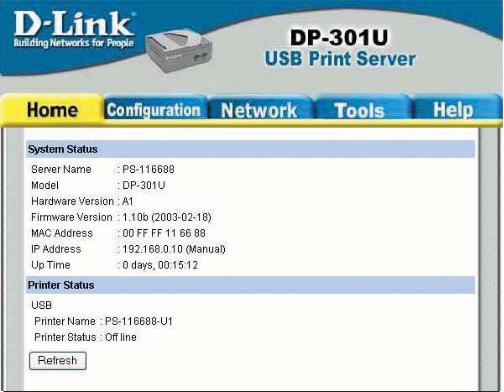
Home
Click on Home tab from the tools bar of the main screen to display information of the DP-301U’s System Status and Printer Status.
System Status and Printer Status
When you choose and enter the Home tab, it will show you the system information (see below), providing general information regarding the Print Server. Click on the <Refresh> button to acquire the most updated information. Once a printer is connected to the Print Server, the Printer Status will show [Online].
Server Name: The name assigned to the Print Server. |
|
Model: The model of the Print Server. |
|
Hardware Version: The version of the hardware on the Print Server. |
|
Firmware Version: The version of the firmware and release date on the |
|
Print Server. |
|
MAC Address: The MAC address of the Ethernet port. |
|
IP Address: The IP Address of the Print Server. |
11 |
Up Time: The length of time the Print Server has been up. |
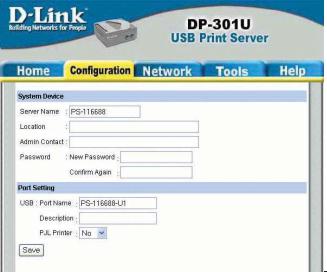
Configuration
Click on Configuration tab from the tools bar of the main screen to enter the Configuration Page; it provides the configuration options that include System Device and Port Setting
System Device and Port Setting
This option will show you settings required to configure the DP-301U Print Server. Consult your printers owner manual for the PJL(Printer Job Language) and print speed supported on your printer. Click the <Save> button on the bottom of the configuration page to ensure the settings are updated and saved.
Server Name: The name assigned to the Print Server.
Location: (optional) Input a comment indicating where the Print Server is located. Admin Contact: (Optional) Administrator name for the Print Server.
Password: By default the DP-301U does not have a password. This is a security risk; it is recommended that you enter a password for the Print Server.
Port Name: This is the assigned name for the USB port. Description: (Optional) A brief description for the USB port. Speed: Printer port speed, High or Low.
PJL Printer: This feature is used to support Hewlett-Packard PJL (Printer Job Language) standard for bi-directional printing.
12
Network
Click on the Network tab from the tools bar of the main screen to enter the Network Page; it provides network protocol configuration options that include TCP/IP,
NetBEUI and AppleTalk
TCP/IP Protocol
The TCP/IP Protocol section will show you the settings required to configure the DP-301U Print Server for TCP/IP printing. If you forget your IPAddress, you can use the PS Admin program to configure the DP-301U Print Server. The default IP Address is 192.168.0.10. Click the <Save> button to ensure the settings are updated and saved. NOTE: If you change and save the IP Address of the DP-301U, you would have to make similar changes on your web browser to access the web configuration again.
NetBEUI Protocol
The NetBEUI Protocol section will show you the settings required to configure the DP-301U Print Server for NetBEUI printing. Click the <Save> button to ensure the settings are updated and saved.
AppleTalk Protocol
The AppleTalk Protocol section will show you the settings required to configure the DP-301U Print Server for AppleTalk printing. Click the <Save> button to ensure the settings are updated and saved.
13
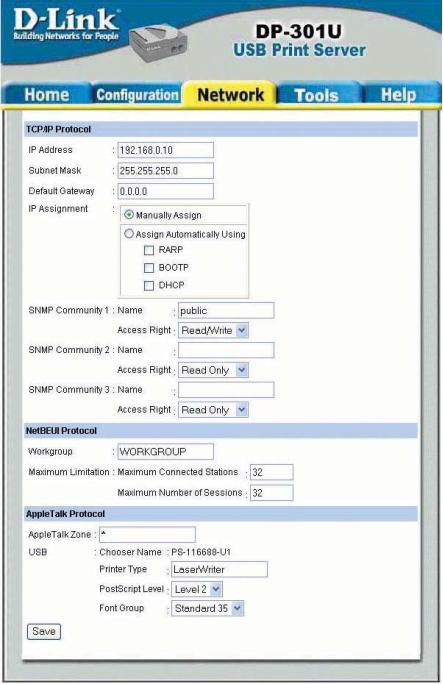
Network
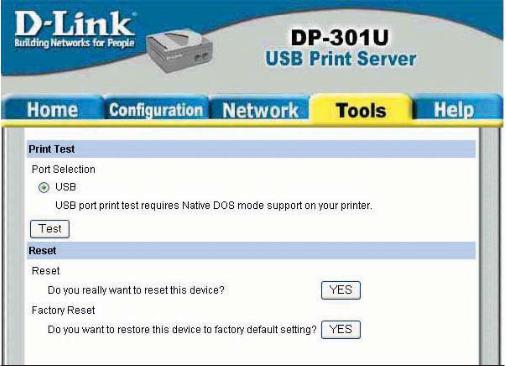
Tools
Click on the Tools link from the tools bar of the main screen to enter the Tools Page; it provides the control options that include Print Test and Reset.
Print Test
Print Test section will allow you to send an ASCII text page from the print server to your printer. Your USB printer will have to support native DOS mode for the test page to print.
Reset
Reset section will allow you to reset your print server. Click the <Yes> button to activate the reset process. Reset will restart the print server. Factory reset will reset all settings to factory default and restart the print server. Default IP address of the print server will be 192.168.0.10 after factory reset.
15
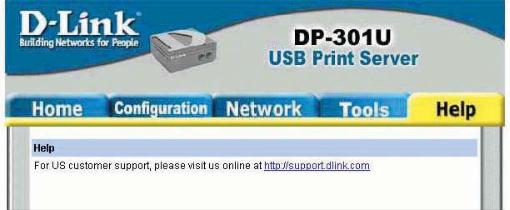
Help
Click on the Help link from the tools bar of the main screen to enter the Help Page, it provides a link to D-Link’s support website. D-Link’s support website will provide the most up to date information on your DP-301U Print Server. Please check the website regularly for product and firmware updates.
16
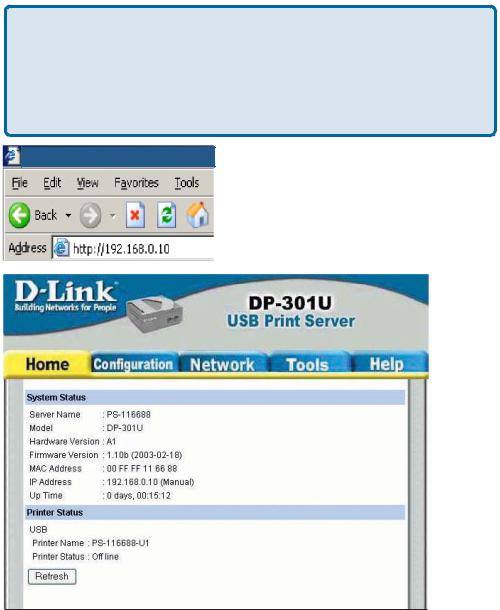
TCP/IP Printing for Windows XP
Open the web browser, and type in the IP Address of the DP-301U.
For example, type http://192.168.0.10 into the Location or Address field. Press the Enter or (Return) Key.
Note:
The PC’s IP Address must be in the same subnet as the Print Server’s IP Address for the two devices to communicate. (For example, if your Print Server’s IP Address is 192.168.0.10, with a subnet mask of 255.255.255.0, then your computer’s IP Address should be 192.168.0.x, where x is a value between 1-254, excluding 10.) See Networking Basics: Assigning a Static IP Address in this manual to find out how to change an IP Address.
D-LinkDP-301U
17
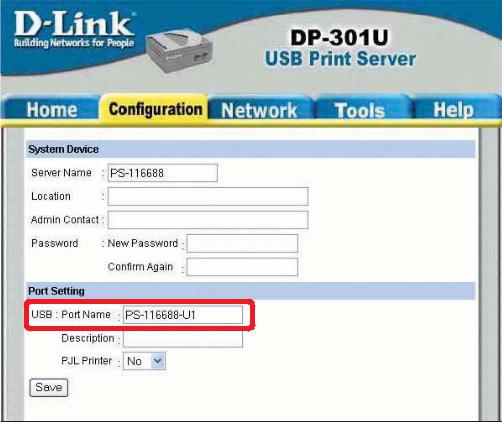
TCP/IP Printing for Windows XP (continued)
At the Configuration window, write down the Port Name for future reference. You will need this information later in the configuration process.
18
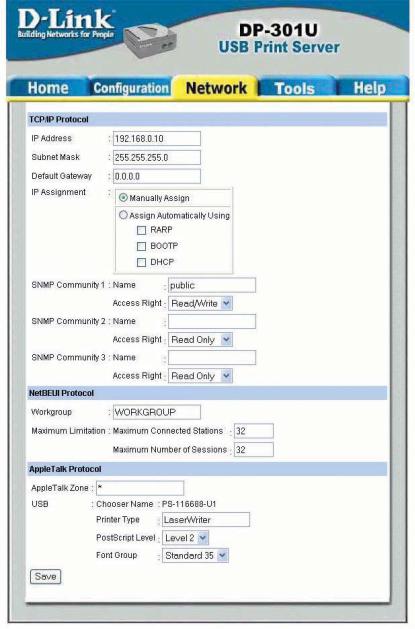
TCP/IP Printing for Windows XP (continued)
When you select TCP/IP Protocol at the Network window, the screen below appears. (We recommend that you keep the default settings as shown.) If you need to make changes, make sure to click Save after you have made the changes. (You may wish to make a note of the IP Address.)
19
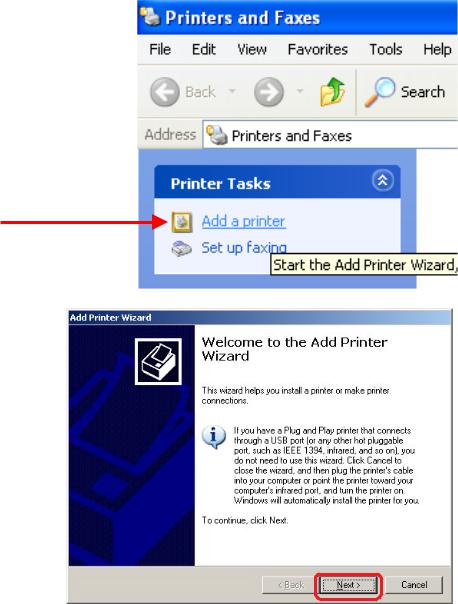
TCP/IP Printing for Windows XP (continued)
Go to Start > Settings >
Printers and Faxes >
Add a Printer
Click Next
20
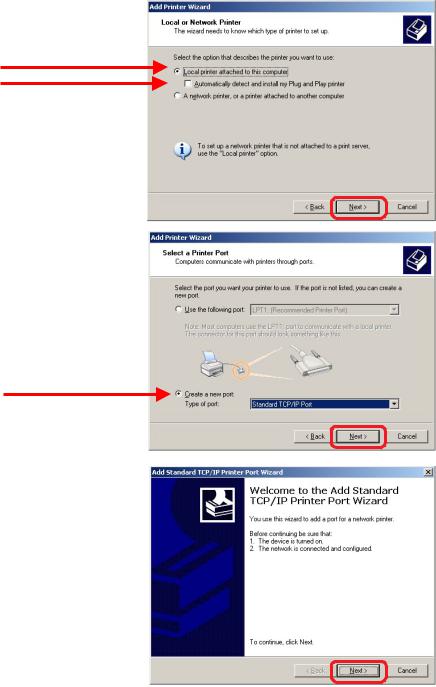
TCP/IP Printing for Windows XP (continued)
Select Local Printer
Deselect Automatically detect and install my Plug and Play printer.
Click Next
Select Create a new port. At the pull-down menu, highlight
Standard TCP/IP Port.
Click Next
Click Next
21

TCP/IP Printing for Windows XP (continued)
Type in the IP address of the Print Server (i.e. 192.168.0.10). The Port Name will automatically be filled in.
Select “Custom”
Then click on Settings.
Select “LPR”
Input the port name of the port being used by the printer
Click OK
22
